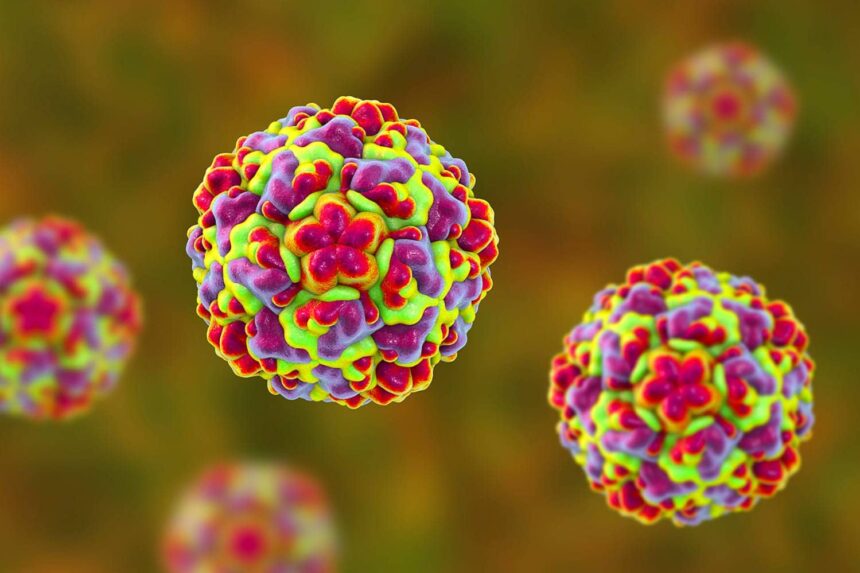What is Rhinovirus?
Rhinovirus, often associated with the common cold, is a viral infection that primarily affects the nose. The name “rhino virus” comes from the Greek word “rhino,” meaning nose, and “virus,” referring to the microorganism. It is important to note that rhinovirus is unrelated to rhinoceroses.
This virus belongs to the Picornaviridae family and is part of the Enterovirus genus. Rhino virus is a non-enveloped virus, meaning it lacks a viral envelope. It has a positive-sense, single-stranded RNA genome, making it a common cause of seasonal flu and the common cold.
Epidemiology and Transmission
Rhino-virus is one of the most common viruses responsible for upper respiratory infections, especially in the spring and fall seasons. More than 100 serotypes of rhino-virus exist, making it highly versatile and difficult to combat.
Transmission occurs through:
- Respiratory droplets
- Direct contact with infected surfaces or individuals (fomites)
- Crowded environments, such as classrooms or public transport
The virus primarily infects the epithelial cells of the upper respiratory tract. Cold temperatures often exacerbate the infection.
How Rhinovirus Infects the Body
Rhino-virus attaches to ICAM-1 receptors on the surface of host cells, leading to receptor-mediated endocytosis. The virus enters the host cell, and the acidic environment within the cell causes the virus’s protein shell (capsid) to disassemble, releasing its RNA genome.
The RNA is then translated into proteins, which assemble new viral particles in the endoplasmic reticulum. These new particles are processed and transported by the Golgi apparatus and then released from the infected cell to spread and infect other cells.
The Body’s Defense Mechanism
While the rhino-virus attacks the body, the immune system fights back with cytotoxic CD8+ T cells and interferon responses, which are crucial in managing viral infections.
Clinical Symptoms of Rhino-virus Infection
Rhino-virus infections typically present with the following symptoms:
- Sudden onset of fever
- Cough
- Sore throat
- Muscle aches
- Headaches
- Fatigue
Some individuals may develop complications such as:
- Bronchitis
- Sinusitis
- Otitis media
- Asthma or COPD exacerbations (rare)
The Course of the Illness
The incubation period for rhino-virus is generally 1 to 3 days, and symptoms typically last around 2 weeks. Here’s a general timeline:
- Fever tends to subside within 2 to 3 days.
- Runny nose may persist for up to a week.
- Coughing can linger for over 14 days.
Diagnosis and Testing
In most cases, diagnosing rhinovirus does not require laboratory tests. The diagnosis is usually based on clinical symptoms and is often made during the peak flu season. However, in severe cases, PCR testing can confirm the presence of the virus.
Read Also… Histone methylation, Histone modification, Gene expression regulation
Treatment and Management
Unfortunately, there is no specific antiviral treatment for rhinovirus, and there is currently no vaccine available. The main management strategy involves allowing the body to fight the infection naturally.
Tips for Managing the Symptoms:
- Rest and stay hydrated.
- Analgesics and antipyretics can help alleviate symptoms.
- Avoiding close contact with others to prevent spreading the infection.
Frequently Asked Questions (FAQ)
Q: What causes the common cold? A: The common cold is most often caused by rhinovirus, which infects the upper respiratory tract.
Q: How is rhinovirus transmitted? A: Rhinovirus is transmitted through respiratory droplets, direct contact, and fomites, often spreading in crowded places.
Q: How long does the infection last? A: The symptoms of a rhinovirus infection can last from a few days to two weeks, with coughing sometimes continuing for more than 14 days.
Q: Is there a cure for rhinovirus? A: There is no specific antiviral treatment for rhinovirus. The infection typically resolves on its own with proper rest and hydration.
Q: Can rhinovirus cause complications? A: In rare cases, rhinovirus infection can lead to complications like bronchitis, sinusitis, and exacerbation of asthma or COPD.


